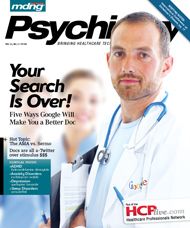Bonus or Bogus? Are federal funds for health IT a true stimulus, or merely a stopgap?
What do physicians really think about the HITECH act, health IT stimulus incentives, and the government’s new role in their lives? Using the power of social media, we did a little research and asked MDNG readers to share their opinions, concerns, and advice.
Since the HITECH Act was signed into law, physicians have had more questions than answers for the Office of the National Coordinator for Health Information Technology, the branch of the Department of Health and Human Services tasked, along with The Centers for Medicare & Medicaid, with overseeing the implementation of the incentive program outlined in the HITECH Act. The two biggest questions have been what constitutes a certified EHR under the rules of the program, and what exactly does “meaningful use” mean when it comes to qualifying for the incentive payments?

A preliminary answer to the meaningful use question was released by the HIT Policy Committee on June 16. The intro to the “meaningful use matrix” stated in part that the HIT Policy Committee recommends that:
“...the ultimate goal of meaningful use of an Electronic Health Record is to enable significant and measurable improvements in population health through a transformed health care delivery system. The ultimate vision is one in which all patients are fully engaged in their healthcare, providers have real-time access to all medical information and tools to help ensure the quality and safety of the care provided while also affording improved access and elimination of health care disparities. This “north star” must guide our key policy objectives, the advanced care processes needed to achieve them, and lastly, the specific use of information technology that will enable the desired outcomes, and our ability to monitor them...”
The Committee went on to note that “the recommended definition of meaningful use will depend on the healthcare setting in which it is employed. Thus, some features and capabilities will be recommended as required in an ambulatory setting before similar functions are expected to be widely used in the hospital. This reflects both the availability of the technology in these different settings as well as the potential impact of these features on the health of the population served. Although some recommended measures used to assess meaningful use in 2011 may apply to specific chronic diseases, the recommended 2011 objectives are meant to establish a foundation for effecting a more comprehensive set of health outcomes in the future. Many of the current proposed EHR-generated quality measures apply to primary care providers and are derived from NQF-endorsed measures. New measures under development, by NQF, and other recognized organizations will also address the work of specialists. The Workgroup anticipates that future recommended meaningful use objectives and measures will reflect emerging national priorities.”
Finally the Committee pointed out that “in identifying potential criteria for meaningful use of an electronic health record, it became apparent that there are considerable gaps in EHR-generated measures available to monitor key desired policy outcomes, (eg, efficiency, patient safety, care coordination). While these measures will not be required for Medicare and Medicaid incentive payments until 2013, the Workgroup is seeking feedback on how to best frame these measures including measurement of key public health conditions, measuring health care efficiency, and measuring the avoidance of certain adverse events. These comments will be used to help revise the recommended measurement strategy to include more extensive and refined outcome measures for “meaningful use” in 2013 and beyond.”
The first working definition of meaningful use is laid out in a meaningful use matrix, a document that matches specific “care goals” with health outcomes policy priorities and explains the year-to-year objectives for achieving these through the use of EHRs. The complete document can be accessed at http://tinyurl.com/l8kcvm.
The Office of the National Coordinator for Health Information Technology (ONC) is seeking comments, questions, and suggestions from physicians, vendors, payers, patients, and other healthcare stakeholders on the preliminary definition of “meaningful use.” The American Health Information Management Association was first to chime in, with recommendations offered on June 26. Visit http://tinyurl.com/lmljm9 to access a schedule of upcoming Health IT Policy Committee meetings, as well as transcripts and other materials from previous meetings. The public is invited to submit comments at the conclusion of each meeting.
Our Readers Weigh in
As can be expected, MDNG readers had a lot to say about all of this. And they’ve never had so many ways of making their voices heard before. Between Twitter tweets, comments on HCPLive.com, responses to our “Hot Topic” eDigests, e-mails to our editors, blog posts, and messages on discussion forums, MDNG readers had ample opportunity to share their thoughts. We’ve compiled the best of the best ideas and opinions:
“The bar has been set too high and the recommendations put forth will be virtually impossible to implement within the aggressive time schedule of the HITECH Act. Simply put, it appears that not enough attention was paid to the processes/workflow changes that are required as part of a successful HIT roll-out to meet these MU recommendations. For example, recommendations call for CPOE use in 2011. CPOE is extremely challenging to implement and the technology piece is actually a pretty small component of the overall implementation. The real challenge with CPOE is its direct impact on physician workflow and practices. Thus, CPOE requires significant forethought, process mapping, implementation and training. Getting all that done and to demonstrate meaningful CPOE use by 2011? Don’t bet on it.”
— John Moore, Chilmark Research
“This is just the beginning of a long conversation. Today, the HIT Policy Committee met and highlighted some of the essential components that outlines this mysterious phrase, ‘meaningful use.’ We won’t see physicians meaningfully using an EHR overnight. This will happen in three stages (although many things will also be happening simultaneously): Data capture and sharing by 2011; advanced clinical processes by 2013; and improved outcomes by 2015.”
— From HCPLive Network member Joseph Kim, MD, on his blog Medicine and Technology.
Taken from www.emrupdate.com, a website dedicated to “unbiased independent EMR discussions”:
“I am a tad confused. I have an EMR. Other physician groups have other brands of EMR. The hospital has no formal electronic record, but the nurses document electronically, and labs and rads are accessed through a portal (no CPOE or physician electronic charting). Who is supposed to create the features that will meet the “meaningful use” guidelines in this situation?”
Respond to this user (imemod) at www.emrupdate.com/forums/p/20003/98803.aspx.
I am sure that someone will come up in future with perfect system but at present it will cost at least $44,000 or more to implement the EHR/ EMR for every practice. The subsidy from government will help but in the end physicians will end up paying the difference. Hopefully this will be worthwhile in the longer run due to ease of finding charts in the practice and other EHR/EMR benefits.
— Alex Pujari
EMR no doubt will save doctors money in the long run, especially in reducing staff salary. I think in a busy practice, it takes at least one person who has to search, file, copy, reshelf, etc. paper charts. Some of the EMR systems, however, are so complex and costly that whatever the amount the government will ACTUALLY give out might not be enough.
— Duc “Duke” Do, MD
You do not install an EMR system on Monday and become “meaningful use” compliant by Tuesday; this is a social integration process that can take months to smoothly function! You MUST allow sufficient time and money for training. Plus, the number of QUALIFIED health IT personnel to help with hardware upgrades and software installation and coaches to help with the implementation is finite and they will be avalanched in 2010 & 2011 (read: more scarce and more expensive than today).
— Victoria Rochford
Comments taken from “I’ll Get $44,000 to use an EHR? Where Do I Sign Up?” a recent column written by MDNG: PC/Cardiology Edition Physician Editor-in-Chief Jonathan Bertman, MD. To respond to these commenters or Dr. Bertman, visit www.hcplive.com/mdnglive/articles/PC_use_an_EHR.
The $787 Billion American Recovery and Reinvestment Act (ARRA) of 2009 (aka “the Stimulus Bill”) was signed into law on February 17, 2009. Included in this law is $19.2 billion which is intended to be used “to increase the use of electronic health records (EHR) by physicians and hospitals; this portion of the bill is called, the Health Information Technology for Economic and Clinical Health Act, or HITECH Act.”
Technology for the Future of Health and Care
“ARRA authorizes the Centers for Medicare & Medicaid Services (CMS) to provide a reimbursement incentive for physician and hospital providers who are successful in becoming “meaningful users” of an electronic health record (EHR). These incentive payments begin in 2011 and gradually phase down. Starting in 2015, providers are expected to have adopted and be actively utilizing an EHR in compliance with the meaningful use definition or they will be subject to financial penalties under Medicare.”
Healthcare Is All a-Twitter about HITECH
Twitter is buzzing with physicians, CMIOs, HIT vendors, and other healthcare stakeholders commenting on the latest about the HITECH Act, meaningful use, CCHIT, the nuances of “certified,” and everything else related to the use of EHRs and other information technology in medical practice. Here’s just a sample.
Ftvelasco - My take is that #CCHIT is addressing the structural component of ARRA. Other #HITPol criteria need to be satisfied to qualify for ARRA bonus
Dirkstanley - confused by the uneven correlation between goals and objectives in the HIT Meaningful Use Matrix. http://bit.ly/tf2yW #HITpol
BeckersASC - ASCs in Danger of Being Excluded from HITECH Incentive Funds http://tinyurl.com msxaqs
EMR_Advocate - #CCHIT #HITpol All vendors will need to certify/re-certify for ARRA including 2008 CCHIT vendors (“delta process”)
Pamorin - Numerous EHRs officially dead as won’t meet the min 2011 criteria w/out massive development. #hitpol (via @john_chilmark)
Perryholz - “Meaningful use” turned out not so meaningful. Do over. http://bit.ly/Qc7g7
Cascadia - “meaningful use” is ultimately linked to achieving measurable outcomes in patient engagement, care coordination, & population health
CanadianEMR - Meaningful use in the US. Bar set too high with too little attention to process/ workflow changes. http://tinyurl.com/n633vn
